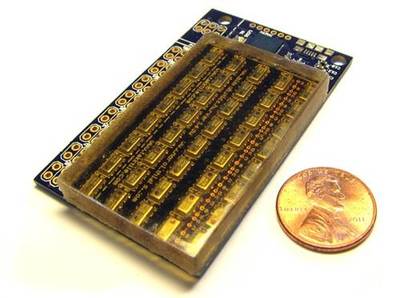Tactile sensing technology gives robots lighter touch
Harvard researchers have developed an inexpensive tactile sensor for robotic hands that they say is sensitive enough to turn a brute machine into a dexterous manipulator.
Designed in the Harvard Biorobotics Laboratory at the Harvard School of Engineering and Applied Sciences (SEAS), the TakkTile sensor has been designed to put high-end technology within the reach of commercial inventors, teachers and robotics enthusiasts.

“Despite decades of research, tactile sensing hasn’t moved into general use because it’s been expensive and fragile,” said co-creator Leif Jentoft, a graduate student at SEAS.
“It normally costs about $16,000, give or take, to put tactile sensing on a research robot hand. That’s really limited where people can use it. The traditional technology also uses very specialised construction techniques, which can slow down your work. Takktile changes that because it’s based on much simpler and cheaper fabrication methods.”
TakkTile takes an existing device - a tiny barometer, which senses air pressure - and adds a layer of vacuum-sealed rubber to it, protecting it from as much as 25 pounds of direct pressure. Jentoft and co-creator Yaroslav Tenzer, a postdoctoral fellow, say that the chips can even survive a strike from a hammer or a baseball bat. At the same time, Takktile is sensitive enough to detect a very slight touch.
When added to a mechanical hand, the robot reportedly ‘knows’ what it is touching. Jentoft and Tenzer say it can pick up a balloon without bursting it, and pick up a key and use it to unlock a door.
The TakkTile creators say the sensor could be used in a range of electronic devices. A toy manufacturer could make a stuffed puppy that responds to patting; a medical device designer could create a laparoscopic gripper that’s gentle enough to tease apart tissue during surgery.
“Not everyone has the bandwidth to do the research themselves, but there are plenty of people who could find new applications and ways of using this,” said Tenzer.
The sensors can be built using relatively simple equipment; the patented process relies on standard methods used in printed circuit board fabrication, along with access to a vacuum chamber. The tiny barometers are available cheaply because they have been widely used in mobile phones and GPS units that can sense altitude.
Along with their adviser Robert D Howe, Abbott and James Lawrence Professor of Engineering at SEAS, Jentoft and Tenzer are pursuing commercial opportunities with help from Harvard’s Office of Technology Development. Harvard plans to license the technology to companies interested in offering prefabricated sensors or in integrating TakkTile sensing into products such as robots, consumer devices and industrial products.
CSIRO electrolyser pilot a success at Bluescope Steel
CSIRO's solid oxide electrolysis technology has clocked 1000 hours of successful operation in...
Three states announce BESS projects in a week
Three Australian states have made announcements about major grid battery and solar utility...
CSIRO solar venture nets record seed funding
FPR Energy is a new venture that aims to help reduce industrial emissions in heavy industries,...












